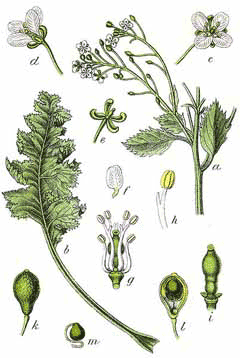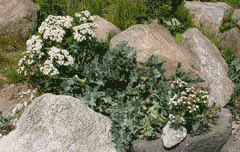 |
|
http://commons.wikimedia.org/wiki/File:Crambe_maritima_Sturm39.jpg |
 |
| http://commons.wikimedia.org/wiki/User:StenCrambe orientalis |
Translate this page:
Summary
Physical Characteristics

 Crambe maritima is a PERENNIAL growing to 0.6 m (2ft) by 0.6 m (2ft in).
Crambe maritima is a PERENNIAL growing to 0.6 m (2ft) by 0.6 m (2ft in).
See above for USDA hardiness. It is hardy to UK zone 5 and is not frost tender. It is in flower from June to August. The species is hermaphrodite (has both male and female organs) and is pollinated by Bees, flies. The plant is self-fertile.
It is noted for attracting wildlife.
Suitable for: light (sandy), medium (loamy) and heavy (clay) soils and can grow in nutritionally poor soil. Suitable pH: neutral and basic (mildly alkaline) soils and can grow in saline soils.
It can grow in semi-shade (light woodland) or no shade. It prefers dry or moist soil and can tolerate drought. The plant can tolerate maritime exposure.
UK Hardiness Map
US Hardiness Map
Synonyms
Plant Habitats
Ground Cover; Cultivated Beds;
Edible Uses
Edible Parts: Flowers Leaves Root Shoots
Edible Uses:
Young leaves - raw or cooked like spinach[9, 12, 37, 52, 183]. They have a pleasant almost nutty flavour and go well in a mixed salad[K]. They also make a very pleasant cooked vegetable[K]. Older leaves develop a bitterness and are not so pleasant[K]. Young shoots - raw or cooked[2, 5, 37, 46, 183]. Available in the spring, they have a delicate nutty flavour with a crisp texture[200, 264]. The shoots are usually blanched and can be cooked like asparagus[9, 183]. When properly cooked they retain their crispness and have a very agreeable flavour, somewhat like hazelnuts but with a slight bitterness[183]. Root - cooked. Rich in starch and sugars[74]. Young flower buds - raw or cooked[264]. The flowering shoots are harvested when about 10 - 15cm long and before the flowers have opened. Used like sprouting broccoli, they are quite nice raw and delicious when lightly steamed[K].
References More on Edible Uses
Medicinal Uses
Plants For A Future can not take any responsibility for any adverse effects from the use of plants. Always seek advice from a professional before using a plant medicinally.
None known
References More on Medicinal Uses
The Bookshop: Edible Plant Books
Our Latest books on Perennial Plants For Food Forests and Permaculture Gardens in paperback or digital formats.

Edible Tropical Plants
Food Forest Plants for Hotter Conditions: 250+ Plants For Tropical Food Forests & Permaculture Gardens.
More

Edible Temperate Plants
Plants for Your Food Forest: 500 Plants for Temperate Food Forests & Permaculture Gardens.
More

More Books
PFAF have eight books available in paperback and digital formats. Browse the shop for more information.
Shop Now
Other Uses
References More on Other Uses
Cultivation details
An easily grown plant, succeeding in a good loam and an open sunny position[1, 111, 200] but also tolerating some shade[188]. Prefers a slightly alkaline soil in a position sheltered from strong winds[200] (this report totally conflicts with the plants native habitat which is on sea shores - we have found this species to be very tolerant of strong maritime winds though it does not like cold northerlies much[K]). Tolerates poor soil and some shade[200]. Dislikes acid[1] and very stiff soils[37]. Prefers a rich , well-drained very deep sandy loam and a pH of 7[104, 264]. Established plants are very drought tolerant[190]. This species is hardy to about -20°c[187], it grows best in a cool maritime climate[200]. Seakale is sometimes cultivated for its edible young shoots in the spring which are blanched by excluding light in order to make them less bitter[61, 264]. Two or three crops can usually be harvested each year[264]. There are some named varieties[183]. The roots are sometimes brought into a greenhouse in the winter and grown on there in order to produce an early crop of shoots[183]. A deep-rooted and very long-lived plant[233, 264], it dislikes root disturbance[164]. The seed is dispersed by seawater, on which it can float for several days without loss of viability[17]. A good bee plant[115]. The plant is heat tolerant in zones 9 through 6. (Plant Hardiness Zones show how well plants withstand cold winter temperatures.
Plant Heat Zones show when plants would start suffering from the heat.
The Plant Heat Zone map is based on the number of "heat days" experienced in a given area where the temperature climbs to over 86 degrees F (30°C).
At this temperature, many plants begin to suffer physiological damage. Heat Zones range from 1 (no heat days) to 12 (210 or more heat days).
For example Heat Zone. 11-1 indicates that the plant is heat tolerant in zones 11 through 1.) For polyculture design as well as the above-ground architecture (form - tree, shrub etc. and size shown above) information on the habit and root pattern is also useful and given here if available. The plant growth habit is a clumper with limited spread [1-2]. The root pattern is a tap root similar to a carrot going directly down [1-2].
References Carbon Farming Information and Carbon Sequestration Information
Temperature Converter
Type a value in the Celsius field to convert the value to Fahrenheit:
Fahrenheit:
The PFAF Bookshop
Plants For A Future have a number of books available in paperback and digital form. Book titles include Edible Plants, Edible Perennials, Edible Trees,Edible Shrubs, Woodland Gardening, and Temperate Food Forest Plants. Our new book is Food Forest Plants For Hotter Conditions (Tropical and Sub-Tropical).
Shop Now
Plant Propagation
Seed - sow March/April in a seedbed outdoors and either thin the plants out or move them to their permanent positions when about 10cm tall[111]. Plants can be cropped once they are more than 12 months old[264]. The young plants are very attractive to slugs so some protection will often be needed. Germination can be slow so it is best to sow the seed in pots in a cold frame[164]. Germination usually takes place in 3 - 26 weeks at 15°c[164]. Prick out the seedlings into individual pots as soon as they are large enough to handle and plant out into their permanent positions when they are at least 10cm tall. Division in spring or autumn[1, 111]. Dig up the root clump and cut off as many sections as you require, making sure they all have at least one growing point. The larger of these divisions can be planted out straight into their permanent positions, though small ones are best potted up and grown on in a cold frame until they are established. Root cuttings, 3 - 10 cm long, in spring[104]. These can be planted straight into the open ground or you can pot them up in the greenhouse and plant them out once they are growing strongly.
Other Names
If available other names are mentioned here
Native Range
TEMPERATE ASIA: Ciscaucasia, Krasnodar, Russian Federation,Russian Federation-Ciscaucasia. EUROPE: Denmark, Finland (south), United Kingdom (U.K.), Ireland, Norway, Sweden (south), Belgium, Germany (north), Netherlands (north), Russian Federation-European part, European part (southwest), Estonia, Lithuania, Latvia, Ukraine (s. & Krym), Bulgaria (east), Romania (east), Turkey, Tekirdag, Istanbul, France (north),
Weed Potential
Right plant wrong place. We are currently updating this section.
Please note that a plant may be invasive in one area but may not in your area so it's worth checking.
Conservation Status
IUCN Red List of Threatened Plants Status :

Growth: S = slow M = medium F = fast. Soil: L = light (sandy) M = medium H = heavy (clay). pH: A = acid N = neutral B = basic (alkaline). Shade: F = full shade S = semi-shade N = no shade. Moisture: D = dry M = Moist We = wet Wa = water.
Now available:
Food Forest Plants for Mediterranean Conditions
350+ Perennial Plants For Mediterranean and Drier Food Forests and Permaculture Gardens.
[Paperback and eBook]
This is the third in Plants For A Future's series of plant guides for food forests tailored to
specific climate zones. Following volumes on temperate and tropical ecosystems, this book focuses
on species suited to Mediterranean conditions—regions with hot, dry summers and cool, wet winters,
often facing the added challenge of climate change.
Read More
Expert comment
Author
L.
Botanical References
17200
Links / References
For a list of references used on this page please go here
Readers comment